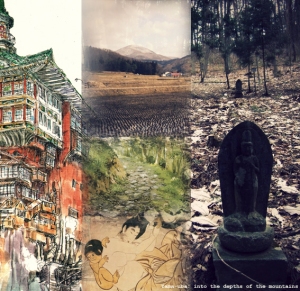This article was published on the JET Programme Social Network.
‘Modern Japan is so thin and shallow and fake. I look forward to when developers go bankrupt, Japan gets poorer and wild grasses take over.’
Hayao Miyazaki
Throughout his career, Hayao Miyazaki has never failed to vocalise his critique of today’s Japan. In Spirited Away – arguably his most successful work of all time — he hands us an alternative vision of his homeland, gleaming with the fantastic, the ambiguous and the surreal. Between the fleshy folds of a Radish Spirit stuffed into an elevator; across the steamy rusted pipes of a dank bathhouse boiler room; behind the chalky masks of famished gods soaking in bubbly tubs-his world heaves under the weight of Japanese spiritual lore. Although deeply linked with tradition and myth, Spirited Away also invokes the realities of contemporary Japanese society, and often draws upon the roots of real Japanese landscapes left forgotten and hidden away. In this short article, I will briefly explore several such places scattered across the country. I hope it will serve as a small reminder of the film’s message- that the strange and the mysterious are not always so beyond our reach as we might think.
Kamikakushi and relics of the recent past
In Spirited Away, Chihiro finds the entrance to the spirit world in a ghostly amusement park. Known as ‘haikyo’ in Japanese, abandoned places such as these largely exist as relics of the country’s rapid urbanisation and the Bubble Economy of the 1980′s. From Hashima Island, Nagasaki, to Takakononuma Greenland, Fukushima (pictured), haikyo pepper Japan’s landscape like faded old scars. The amusement park of Spirited Away is a man-made world that has slowly and silently succumbed to the erosive forces of nature. Its eerie presence gives refuge to spirits that have suffered human neglect, a place of kamikakushi — hidden away by gods –and a crossing between contemporary Japan and the spirit world.
Yama-uba: into the depths of the mountains
Given that 71% of Japan’s geography is mountainous terrain, it hardly comes as a surprise that mountains are viewed as a vital part of folklore and culture. Considered sacred places, they teem with wild spirits, witches and wolves, concealed by the spindly trunks of deep unpeopled forests. Many such landscapes exist across Japan, including Touno village, Iwate (pictured), that have become associated with the mythic and the mysterious. Spirited Away draws upon the imaginative power of the mountains, most notably by depicting the Witch of the Bathhouse, Yubaba, as closely resembling one of the most well-known figures of mountain folklore- the Mountain Hag, or Yama-uba (pictured). Appearing in countless works of literature, Yama-uba is described as a crone that cares for the ancient mountains of Japan. With her wide gaping mouth, unkempt hair and tattered kimono, she lures and eats travellers. Despite her cannibalistic tendencies, she is also considered a benevolent spirit, tending after her super-sized child, Kintarou. If Yubaba from Spirited Away is a mirror of Yama-uba, the bathhouse that she presides over may be a testament to the Japanese ancient mountain, from its dark dank roots to the elaborate and majestic peak, a place brimming over with the fantastic and the strange.
The Tokyo Desert, the faceless and the friendless
The bathhouse in Spirited Away is a primary setting, and offers several readings of the Japanese landscape and Japanese society’s obsession with hierarchy. Through Chihiro’s journey, we witness many aspects of the bathhouse, from the factory-like machinations of Kamaji’s boiler room, to Yubaba’s decorated lofts, covered in gleaming jewels and Western treasures. There is a clear sense of socio-economic structure to the place that acts as a microcosm of capitalism in Japan, particularly in large cities like Tokyo (pictured). A vocal critic of capitalism, Miyazaki shows how it has led to greed and loneliness through the character of No-Face, or Kao-nashi. Appearing as a meek lonely spirit at the beginning of Spirited Away, he becomes easily corrupted by materialism in the bathhouse, and even tries to buy Chihiro’s friendship. He does not return to his original self until he is taken away. Though some people may feel disturbed by No-Face’s attempt to buy Chihiro, this is not far removed the reality of Japanese urban living- where people can ’rent’ friends, where loneliness is as common as Hello Kitty, and where people choose a life of hikikomori, social reclusion, to escape the pressures of life in Japan.
This concludes my short article; I hope it has been an interesting read. There are a huge number of resources that expand upon different aspects of the movie mentioned here, a selection of which I have included below.
References:
http://www.midnighteye.com/interviews/hayao_miyazaki.shtml
http://www.nausicaa.net/miyazaki/sen/proposal.html
http://hayao-miyazaki.tumblr.com/tagged/quote
http://www.corneredangel.com/amwess/papers/spirited_away.pdf
http://www.japan-talk.com/jt/new/the-tokyo-desert-of-loneliness



Discussion
No comments yet.